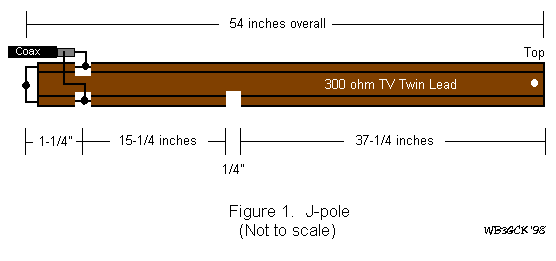 |
The Twinlead J-Pole
Craig LaBarge, WB3GCK |
In an emergency situation, it is often necessary to squeeze every bit of performance possible out of a 2 meter HT. One way to do that is to replace that little rubber duck antenna with the ever-popular Twinlead J-Pole. This simple antenna lends itself well to emergency use or as a portable antenna for hotel room operations while traveling.
There are several features which make the ubiquitous Twinlead J-Pole antenna a good addition to your emergency grab-n-go kit. When rolled up, it is an extremely compact, pocket-sized antenna. In use, it makes for a very effective antenna and provides about 3 db of gain with a low take-off angle. In fact, when used on your HT, it will dramatically out-perform your rubber duckie. And finally, it can be built in no time flat for a few dollars of readily available materials.
Technically-speaking, the J-Pole is an end-fed, halfwave antenna with a quarterwave matching section to allow feeding with 50-ohm coax. Being a halfwave antenna, it is not dependent on a ground or radials for proper performance. That's also a plus for portable operation.
Here's what you'll need to build one for the 2 meter band:
- A 60-inch piece of flat TV twinlead. Use the inexpensive Radio Shack twinlead. Don't use the more expensive foam-filled line.
- 6 feet or more of coax cable. RG-174/U miniature cable makes for a very portable antenna but don't use more than 6 feet of it; it's very lossy. Use RG-58/U if you like, but it will be a bit bulkier.
- Ferrite bead, type 43 material (optional - see below)
- BNC connector (or other connector of your choice)
Here's how you build it:
- First, take the 60 inch piece of twinlead and strip back about 1/2 inch from one end. Twist and solder the two wires together. Keep the connection as short as possible. This will be the bottom of the antenna.
- Next, measure up 1-1/4 inches from the bottom and carefully remove the insulation, exposing both wires, as shown in Figure 1. Keep the notches small (1/8" or so) and be careful not to cut the wires. This is where we will be attaching the coax later.

- Now, attach your coax as shown in Figure 1. [Note: A ferrite bead (type 43 material) can be placed over the outside of the coax near the feedpoint to choke off any RF that might get coupled onto the coax shield. Many plans for this antenna, however, omit the ferrite bead. Your choice. If you experience problems with RF on the rig, go ahead and add the ferrite bead. Alternately, you can wind the coax into a coil of about 5 inches in diameter with 4 turns to create a suitable RF choke.]
- Measure up 15-1/4 inches from the point where the coax braid is attached and make a 1/4-inch notch. This time, you want to cut through the wire. Only cut one notch and make sure it is on the side where the braid is attached. This will form the 1/4 wave matching section.
- Tape the coax to the twinlead for strain relief. Also, tape all solder connections and add some tape at the 1/4-inch notch for added strength.
- Now, measure up from the bottom of the antenna and cut it to an overall length of 54 inches.
That's about all there is to it. To facilitate hanging, punch a small hole in the top of the antenna. Use monofilament fishing line or other non-conductive line through the hole for hanging. The J-Pole is very broad-banded, so it shouldn't require any tuning. (An SWR check, however, is recommended.) Just unroll it, hang it up, and communicate.
© 1998 Craig A. LaBarge



